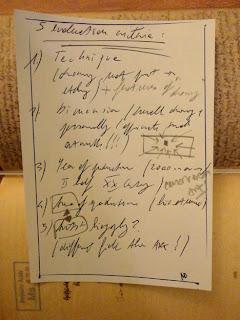 |
| Abbott and Holder display window. |
Once inside, we see that all the space available is filled to the brim.
On the ground floor we find the exhibition "Portraits under pressure" of the contemporary illustrator Michael Daley (British Press Award 1987) with his caricatures for The Financial Times, The Indipendent, The Observer, etc.
All the other three floors are full of framed artworks on the wall and on the floor; unframed drawings, watercolours and prints are arranged in display racks; these are standing on the floor or on chests of drawers (for storing more drawings).
 |
| Display and storing in one of the rooms. |
We check almost all the artworks on display and we discover an incredible ammount of drawing of different dimensions, with affordable prizes too. The range of drawings covers different periods, form XVIII to XX century mostly. In particular, the gallery is concentrated in collecting and selling English art.
It is pleasure to flip through all the material at disposal: handle the drawings, feel the variety of paper used, look in backlight how the artist ruled the lines. And finally, check if on the rear of the work there is a note of a previous owner or a serial number of a private collection. What a strong difference form the detached and distant approach to the artwork of the auction houses!
 |
| Flip through the drawings in a display rack. |
We spend time to take notes and discuss about our personal opinion on the different drawings that corresponds to our personal taste and/or to our collective interest.
In particular, what catch our attention are two different series.
The first is a really particular series dated 1827 by the ornithologist Thomas Bewich (1753-1828). Details, precision and the particular themes represented define this series. Stunning the technique, since it is correlated to the really tiny dimensions of the works (roughly 10x7cm.): Bewich was a wood engraver, so that the series are impressions on paper. Observing the rear of the impressions, I notice a yellow mark, which means thet all the series is already reserved from a possible buyer.
The second series has a landscape subject. On the first drawing, on the top right of the cardboard that frames it, is written on pencil: Samuel Bard 1710-1778. Pen and ink £ 125. The series is not dated, not in the front nor in the rear. Also these works are of a small dimension (roughly 10x10cm.) and particularly detailed. The drawing of the landscape represent also different architectures (houses, castles, etc.), framed by a draw flourish contour. The prizes of the drawings vary from £125 to £225.
These two series present, within the context of our project, two problems.
We want to purchase a drawing, so an artworks that present the technical characteristic of the drawing. In this case the first series by Thomas Bewich is out of interest, since is produced with impression on paper.
Secondly, the series are dated, respectively, first half of the XIX century and XVIII century. Which means that if our interest is concentrated in the contemporary or, at least, second half of the XX century, both series are out of our goal.
 |
| Framed drawings and watercolours leaned on the floor. |
We go back on the groundfloor and we meet the Director, Philip Athill, whom kindly answer to some questions about the gallery. When we explain the drawing project he looks interested, he show us a drawing hang in the gallery by Rydal Hanbury, contemporary artist. He shows us her website. His suggestion is to contact her directly and write that he, Philip Athill, gave her name to us. The practice of Rydal Hanbury is focused on drawing and she is also keen to participate in artistic projects. We will, of course, write her soon.
Visit the Abbott and Holder website:
http://www.abbottandholder.co.uk/
Michele Drascek




















